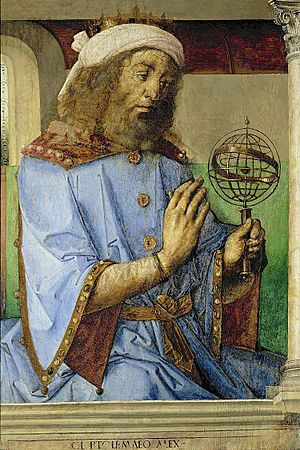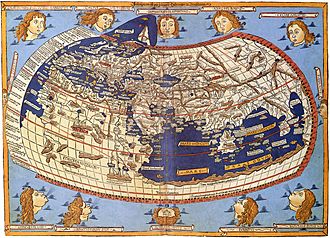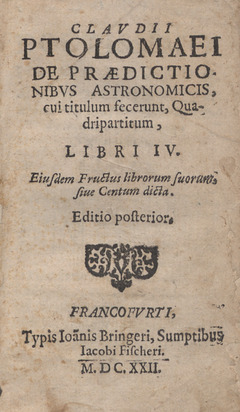Ptolemy facts for kids
Quick facts for kids
Ptolemy
|
|
|---|---|
| Κλαύδιος Πτολεμαῖος | |

Portrait of Ptolemy by Justus van Gent and Pedro Berruguete (1476)
|
|
| Born | c. 100 AD Egypt, Roman Empire
|
| Died | c. 170 (aged 69–70) AD Alexandria, Egypt, Roman Empire
|
| Citizenship | Roman; ethnicity: Greco-Egyptian |
| Known for | Ptolemaic universe Ptolemy's world map Ptolemy's intense diatonic scale Ptolemy's table of chords Ptolemy's inequality Ptolemy's theorem Equant Evection Quadrant |
| Scientific career | |
| Fields | Astronomy, Geography, Astrology, Optics |
Claudius Ptolemy ( Greek: Πτολεμαῖος, Ptolemaios; Latin: Claudius Ptolemaeus; c. 100 – c. 170 AD) was an Alexandrian mathematician, astronomer, astrologer, and geographer.
Ptolemy's writings never ceased to be copied or commented upon, both in Late Antiquity and in the Middle Ages. However, it is likely that only a few truly mastered the mathematics necessary to understand his works.
Contents
Biography
Ptolemy lived in or around the city of Alexandria, in the Roman province of Egypt under Roman rule, had a Latin name, which is generally taken to imply he was also a Roman citizen, cited Greek philosophers, and used Babylonian observations and Babylonian lunar theory.
The 14th-century astronomer Theodore Meliteniotes gave his birthplace as the prominent Greek city Ptolemais Hermiou (Πτολεμαΐς Ἑρμείου) in the Thebaid (Θηβᾱΐς). However, there is no evidence to support it.
Claudius Ptolemy died in Alexandria c. 168.
Astronomy
Astronomy was the subject to which Ptolemy devoted the most time and effort; about half of all the works that survived deal with astronomical matters.
Mathēmatikē Syntaxis

Ptolemy's Mathēmatikē Syntaxis (Koine Greek: Μαθηματικὴ Σύνταξις, lit. "Mathematical Systematic Treatise"), better known as the Almagest, is the only surviving comprehensive ancient treatise on astronomy. Although Babylonian astronomers had developed arithmetical techniques for calculating and predicting astronomical phenomena, these were not based on any underlying model of the heavens.
Ptolemy derived each of his geometrical models for the Sun, Moon, and the planets from selected astronomical observations done in the spanning of more than 800 years. He presented his astronomical models alongside convenient tables, which could be used to compute the future or past position of the planets. The Almagest also contains a star catalogue, which is a version of a catalogue created by Hipparchus. For over a thousand years, the Almagest was the authoritative text on astronomy across Europe, the Middle East, and North Africa.
Ptolemy's planetary models, like those of the majority of his predecessors, were geocentric and almost universally accepted until the reappearance of heliocentric models during the scientific revolution.
Handy Tables
The Handy Tables (Koine Greek: Πρόχειροι κανόνες) are a set of astronomical tables, together with canons for their use. Ptolemy arranged the data needed to compute the positions of the Sun, Moon and planets, the rising and setting of the stars, and eclipses of the Sun and Moon in tables, making it a useful tool for astronomers and astrologers. Although Ptolemy's Handy Tables do not survive as such in Arabic or in Latin, they represent the prototype of most Arabic and Latin astronomical tables.
Planetary Hypotheses
The Planetary Hypotheses (Koine Greek: Ὑποθέσεις τῶν πλανωμένων, lit. "Hypotheses of the Planets") is probably one of the last works written by Ptolemy. It deals with the structure of the universe and the laws that govern celestial motion. Ptolemy goes beyond the mathematical models of the Almagest to present a physical realization of the universe as a set of nested spheres. He estimated the Sun was at an average distance of 1,210 Earth radii (now known to actually be ~23,450 radii), while the radius of the sphere of the fixed stars was 20,000 times the radius of the Earth.
The work is also notable for having descriptions on how to build instruments to depict the planets and their movements from a geocentric perspective, presumably for didactic purposes.
Cartography
Ptolemy's second most well-known work is his Geographike Hyphegesis (Koine Greek: Γεωγραφικὴ Ὑφήγησις; lit. "Guide to Drawing the Earth"), known as the Geography, a handbook on how to draw maps using geographical coordinates for parts of the Roman world known at the time. Although maps based on scientific principles had been made since the time of Eratosthenes (c. 276 – c. 195 BC), Ptolemy improved on map projections.
In the third part of the Geography, Ptolemy gives instructions on how to create maps both of the whole inhabited world (oikoumenē) and of the Roman provinces, including the necessary topographic lists, and captions for the maps. His oikoumenē spanned 180 degrees of longitude from the Blessed Islands in the Atlantic Ocean to the middle of China; Ptolemy was well aware that he knew about only a quarter of the globe, and an erroneous extension of China southward suggests his sources did not reach all the way to the Pacific Ocean.
Optics
Ptolemy's Optica (Koine Greek: Ὀπτικά), known as the Optics, survives only in a somewhat poor Latin version, which, in turn, was translated from a lost Arabic version by Eugenius of Palermo (c. 1154). In it, Ptolemy writes about properties of sight, including reflection, refraction, and colour. The work is a significant part of the early history of optics and influenced the more famous and superior 11th-century Book of Optics by Ibn al-Haytham. Ptolemy offered explanations for many phenomena concerning illumination and colour, size, shape, movement, and binocular vision. He also divided illusions into those caused by physical or optical factors and those caused by judgmental factors.
Astrology
Ptolemy wrote an astrological treatise, in four parts, known by the Greek term Tetrabiblos (lit. "Four Books") or by its Latin equivalent Quadripartitum. Its original title is unknown. As a source of reference, the Tetrabiblos is said to have "enjoyed almost the authority of a Bible among the astrological writers of a thousand years or more". It was first translated from Arabic into Latin by Plato of Tivoli (Tiburtinus) in 1138, while he was in Spain.
Much of the content of the Tetrabiblos was collected from earlier sources; Ptolemy's achievement was to order his material in a systematic way, showing how the subject could, in his view, be rationalized.
Music
Ptolemy wrote a work entitled Harmonikon (Koine Greek: Ἁρμονικόν), known as the Harmonics, on music theory and the mathematics behind musical scales in three books.
Although Ptolemy's Harmonics never had the influence of his Almagest or Geography, it is nonetheless a well-structured treatise and contains more methodological reflections than any other of his writings. During the Renaissance, Ptolemy's ideas inspired Kepler in his own musings on the harmony of the world (Harmonice Mundi, Appendix to Book V).
Philosophy
Ptolemy wrote a short essay entitled On the Criterion and Hegemonikon (Koine Greek: Περὶ Κριτηρίου καὶ Ἡγεμονικοῡ), which may have been one of his earliest works. It deals specifically with how humans obtain scientific knowledge (i.e., the "criterion" of truth), as well as with the nature and structure of the human psyche or soul, particularly its ruling faculty (i.e., the hegemonikon). Ptolemy argues that, to arrive at the truth, one should use both reason and sense perception in ways that complement each other. On the Criterion is also noteworthy for being the only one of Ptolemy's works that is devoid of mathematics.
Named after Ptolemy
There are several characters or items named after Ptolemy, including:
- The crater Ptolemaeus on the Moon
- The crater Ptolemaeus on Mars
- The asteroid 4001 Ptolemaeus
- Messier 7, sometimes known as the Ptolemy Cluster, an open cluster of stars in the constellation of Scorpius
- The Ptolemy stone used in the mathematics courses at both St. John's College campuses in the U.S.
- Ptolemy's theorem on distances in a cyclic quadrilateral, and its generalization, Ptolemy's inequality, to non-cyclic quadrilaterals
- Ptolemaic graphs, the graphs whose distances obey Ptolemy's inequality
- Ptolemy Project, a project at University of California, Berkeley, aimed at modeling, simulating and designing concurrent, real-time, embedded systems
- Ptolemy Slocum, actor
Images for kids
-
Engraving of a crowned Ptolemy being guided by Urania, from Margarita Philosophica by Gregor Reisch (1508), showing an early confluence between his person and the rulers of Ptolemaic Egypt.
See also
 In Spanish: Claudio Ptolomeo para niños
In Spanish: Claudio Ptolomeo para niños






